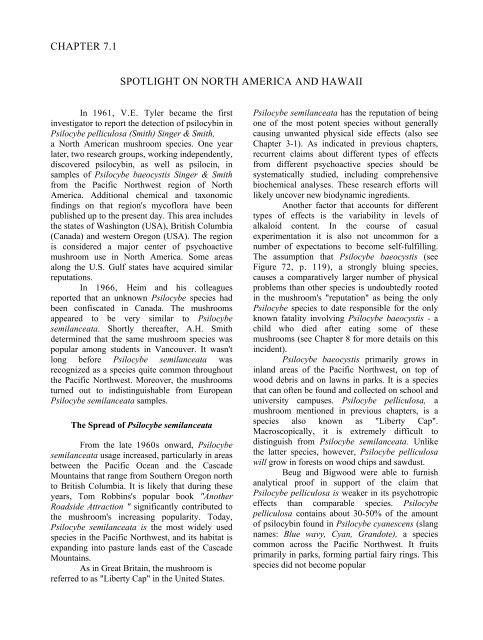Jochen Gartz - Magic Mushrooms Around the ... - preterhuman.net
Jochen Gartz - Magic Mushrooms Around the ... - preterhuman.net
Jochen Gartz - Magic Mushrooms Around the ... - preterhuman.net
Create successful ePaper yourself
Turn your PDF publications into a flip-book with our unique Google optimized e-Paper software.
CHAPTER 7.1<br />
SPOTLIGHT ON NORTH AMERICA AND HAWAII<br />
In 1961, V.E. Tyler became <strong>the</strong> first<br />
investigator to report <strong>the</strong> detection of psilocybin in<br />
Psilocybe pelliculosa (Smith) Singer & Smith,<br />
a North American mushroom species. One year<br />
later, two research groups, working independently,<br />
discovered psilocybin, as well as psilocin, in<br />
samples of Psilocybe baeocystis Singer & Smith<br />
from <strong>the</strong> Pacific Northwest region of North<br />
America. Additional chemical and taxonomic<br />
findings on that region's mycoflora have been<br />
published up to <strong>the</strong> present day. This area includes<br />
<strong>the</strong> states of Washington (USA), British Columbia<br />
(Canada) and western Oregon (USA). The region<br />
is considered a major center of psychoactive<br />
mushroom use in North America. Some areas<br />
along <strong>the</strong> U.S. Gulf states have acquired similar<br />
reputations.<br />
In 1966, Heim and his colleagues<br />
reported that an unknown Psilocybe species had<br />
been confiscated in Canada. The mushrooms<br />
appeared to be very similar to Psilocybe<br />
semilanceata. Shortly <strong>the</strong>reafter, A.H. Smith<br />
determined that <strong>the</strong> same mushroom species was<br />
popular among students in Vancouver. It wasn't<br />
long before Psilocybe semilanceata was<br />
recognized as a species quite common throughout<br />
<strong>the</strong> Pacific Northwest. Moreover, <strong>the</strong> mushrooms<br />
turned out to indistinguishable from European<br />
Psilocybe semilanceata samples.<br />
The Spread of Psilocybe semilanceata<br />
From <strong>the</strong> late 1960s onward, Psilocybe<br />
semilanceata usage increased, particularly in areas<br />
between <strong>the</strong> Pacific Ocean and <strong>the</strong> Cascade<br />
Mountains that range from Sou<strong>the</strong>rn Oregon north<br />
to British Columbia. It is likely that during <strong>the</strong>se<br />
years, Tom Robbins's popular book "Ano<strong>the</strong>r<br />
Roadside Attraction " significantly contributed to<br />
<strong>the</strong> mushroom's increasing popularity. Today,<br />
Psilocybe semilanceata is <strong>the</strong> most widely used<br />
species in <strong>the</strong> Pacific Northwest, and its habitat is<br />
expanding into pasture lands east of <strong>the</strong> Cascade<br />
Mountains.<br />
As in Great Britain, <strong>the</strong> mushroom is<br />
referred to as "Liberty Cap" in <strong>the</strong> United States.<br />
Psilocybe semilanceata has <strong>the</strong> reputation of being<br />
one of <strong>the</strong> most potent species without generally<br />
causing unwanted physical side effects (also see<br />
Chapter 3-1). As indicated in previous chapters,<br />
recurrent claims about different types of effects<br />
from different psychoactive species should be<br />
systematically studied, including comprehensive<br />
biochemical analyses. These research efforts will<br />
likely uncover new biodynamic ingredients.<br />
Ano<strong>the</strong>r factor that accounts for different<br />
types of effects is <strong>the</strong> variability in levels of<br />
alkaloid content. In <strong>the</strong> course of casual<br />
experimentation it is also not uncommon for a<br />
number of expectations to become self-fulfilling.<br />
The assumption that Psilocybe baeocystis (see<br />
Figure 72, p. 119), a strongly bluing species,<br />
causes a comparatively larger number of physical<br />
problems than o<strong>the</strong>r species is undoubtedly rooted<br />
in <strong>the</strong> mushroom's "reputation" as being <strong>the</strong> only<br />
Psilocybe species to date responsible for <strong>the</strong> only<br />
known fatality involving Psilocybe baeocystis - a<br />
child who died after eating some of <strong>the</strong>se<br />
mushrooms (see Chapter 8 for more details on this<br />
incident).<br />
Psilocybe baeocystis primarily grows in<br />
inland areas of <strong>the</strong> Pacific Northwest, on top of<br />
wood debris and on lawns in parks. It is a species<br />
that can often be found and collected on school and<br />
university campuses. Psilocybe pelliculosa, a<br />
mushroom mentioned in previous chapters, is a<br />
species also known as "Liberty Cap".<br />
Macroscopically, it is extremely difficult to<br />
distinguish from Psilocybe semilanceata. Unlike<br />
<strong>the</strong> latter species, however, Psilocybe pelliculosa<br />
will grow in forests on wood chips and sawdust.<br />
Beug and Bigwood were able to furnish<br />
analytical proof in support of <strong>the</strong> claim that<br />
Psilocybe pelliculosa is weaker in its psychotropic<br />
effects than comparable species. Psilocybe<br />
pelliculosa contains about 30-50% of <strong>the</strong> amount<br />
of psilocybin found in Psilocybe cyanescens (slang<br />
names: Blue wavy, Cyan, Grandote), a species<br />
common across <strong>the</strong> Pacific Northwest. It fruits<br />
primarily in parks, forming partial fairy rings. This<br />
species did not become popular








![The Big Lie 9-11 and Government Complicity in Mass Murder [PDF]](https://img.yumpu.com/50957077/1/190x245/the-big-lie-9-11-and-government-complicity-in-mass-murder-pdf.jpg?quality=85)








